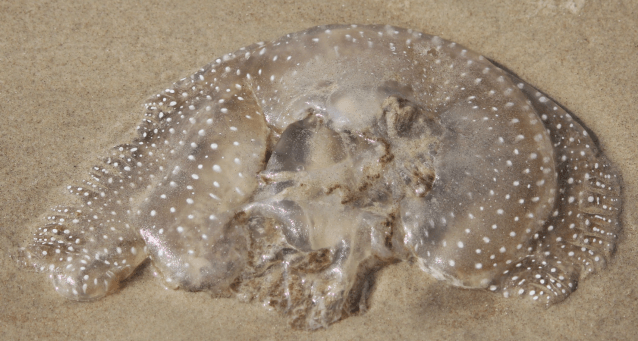Experts sound alarm bells after bizarre blob mysteriously washes up on shore: ‘A not-so-welcome visitor’
One Texas beach recently looked like a scene from a sci-fi movie after a polka-dotted blob surfaced. And while it may have looked harmless, officials said the creature was an unwelcome visitor.
What happened?
On June 30, Padre Island National Seashore posted a picture of an Australian spotted jellyfish on its Facebook page, saying it recently turned up on the island’s North Beach.
The agency went on to explain that this sea creature was a long way from home — the species is native to the western Pacific Ocean but has started to appear in the Gulf of Mexico in recent years.

According to the Fort Worth Star-Telegram, experts don’t know how the species started making its way over to the Americas, but suspect the animals might have hitched rides by attaching to the hulls of ships as juvenile polyps.
Why is this jellyfish concerning?
The Facebook post went on to call the recent arrival “a not-so-welcome visitor.”
While the species is harmless to humans (its venom is too weak to cause any pain), this jellyfish poses a major threat because its voracious eating habits make it harder for local marine wildlife to find food, as the post explains.
“In the Gulf, this invader has formed huge swarms in recent years,” the Texas Invasive Species Institute told the Fort Worth Star-Telegram. “Each jellyfish can clear 50 cubic meters (roughly 1,765 feet) of water filled with plankton in one day.”
A variety of native animals like fish, mollusks, and other jellyfish depend on zooplankton for nutrition.
What’s being done about the jellyfish?
In the Pacific, these jellyfish are managed naturally by snails that eat them during their polyp stage. However, these snails are not present in North American waters. The Texas Invasive Species Institute said little is known about how to control the species.
The organization also said that capturing live jellyfish can help lower jellyfish populations, but there could be millions of them in one area. “Fishermen can only devote so much time to an animal that generates no revenue for them,” it stated on its website.
Unfortunately, there’s not much the average person can do if they come across this invasive species. Officials urged people to leave them where they find them.
That said, reporting any sightings of this species in the Gulf could help experts manage these creatures in the future, according to the institute.
“Vigilant eyes on ocean waters and continual reports of Australian spotted jellyfish sightings can help estimate how many there are within the Gulf of Mexico and further measures can be taken to (eradicate this) invasive animal,” it said.
Join our free newsletter for cool news and cool tips that make it easy to help yourself while helping the planet.
